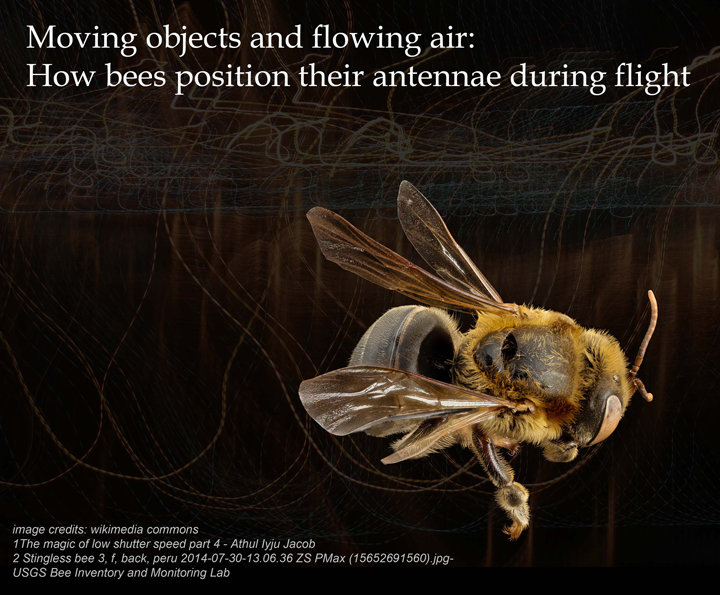Moving objects and flowing air: How bees position their antennae during flight
"Bzzz..." Consider the bee that keeps circling your coffee cup or glass of juice - an unsung pollinator hero helping farmers grow tons of fruit and vegetables for our consumption. You try to shoo it away, but the bee dodges your hand to land neatly on the lip of your cup. After a quick sip of the liquid inside, it's off.
Bees like the one you just tried to wave aside, have a speedometer in their heads - a way to judge how fast and how far they have flown. Although scientists have long known that this speedometer relies heavily on vision to work, new research now suggests that bees may also use airflow to tune their internal speedometers.
Researchers from the National Centre for Biological Sciences (NCBS), Bangalore propose that airflow measured by bee antennae could be critical for their ability to gauge flight speed. And to do this, they must be able to position their antennae correctly.
"You can think of antennae as probes that do very interesting things," says Sane.
Antennae are multipurpose organs - they act as noses, sometimes as tongues to smell and taste substances, they are feelers, and from what Roy Khurana and Sane show, they also help bees fly and navigate.
"Bees position their antennae in a very specific way, and somehow that position is very important for flight, because when we disrupt it, the bees can't fly," says Sane.
In a series of experiments involving trained bees and wind tunnels, Taruni Roy Khurana and Sanjay Sane from NCBS show that vision and airflow work in opposing ways to help bees arrange their antennae accurately during flight.
In a long careful process, Roy Khurana first trained domestic bees with sugar water as bait to fly through a wind tunnel. Wind tunnels - set-ups designed to create precise airflow - are normally used to test the effects of wind on models of aircraft and buildings. In this case, the wind tunnel was used to explore how bees positioned their antennae in response to different air speeds.
With increasing airflow speeds, bees were seen to bring their antennae forward to hold them in specific positions. The faster the airflow, the more forward were the antennae held.
In another set of experiments, the researchers used tethered bees - by attaching each bee to a thin metal rod with super-glue - to study how visual clues affected antenna position. The tethered bees, with LED screens on either side of their eyes, were shown moving images similar to those they would experience when in flight. These moving images made bees move their antennae backward.
A combination of both - moving images and airflow, however, caused the bees to maintain their antennae in a fixed position. The two stimuli, one visual and the other a measure of air drag force, were operating in opposition to help the bee maintain its antennae in a fixed position.
And with good reason - antennal positioning is critical, as the information collected by antennae are often used by flying bees to make decisions in a wingbeat - a fraction of a second. "Even a single decision, if wrong, could lead to a crash," says Roy Khurana.
Roy Khurana and Sane further suggest that bees use airflow to calibrate their internal vision-based speedometers, especially when visual clues are sparse.
"Bees are getting feedback from their eyes and antennae. What they can do, is calibrate across these different senses. They're using input from one sense to calibrate inputs from another sense," says Sane.
But in their experiments, Roy Khurana and Sane found that bees' antennae respond to a very narrow range of air speeds - between 1.5 to 3 meters per second. Measuring flight distances with this sensor would be equivalent to measuring kilometres using a meter scale. Small errors would be compounded to give an inaccurate value of distance.
However, the meter scale can be used to calibrate, say ten steps taken by a person. A count of how many such tens of steps are needed to measure a kilometre, would give much more accurate estimates of kilometre-long distances.
"Therefore, it makes sense to think that bees could be calibrating a large scale system - their visual speedometer, with a small scale - their airflow sensors in antennae, to accurately judge distances," says Roy Khurana.
"We're really very excited about this hypothesis. Though we haven't tested it yet, there's quite a bit of evidence that backs it," she adds.
The work described in this article has been published as a paper titled "Airflow and optic flow mediate antennal positioning in flying honeybees" in eLife and can be accessed at https://elifesciences.org/content/5/e14449#api_box. A podcast about this work produced by eLife can also be downloaded at https://elifesciences.org/podcast/episode30.

Comments
Post new comment